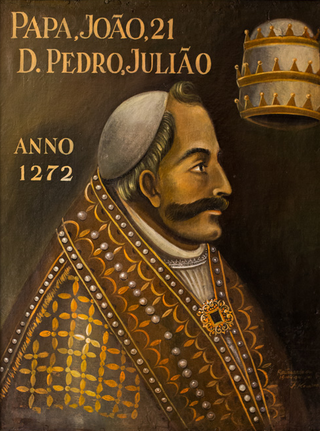
Pope John XXI, born Pedro Julião, was the bishop of Rome and head of the Catholic Church from 8 September 1276 to his death. He is the only Portuguese pope in history. He is sometimes identified with the logician and herbalist Peter of Spain, which would make him the only pope to have been a physician.

Pope Martin IV, born Simon de Brion, was the head of the Catholic Church and ruler of the Papal States from 22 February 1281 to his death on 28 March 1285. He was the last French pope to have held court in Rome; all subsequent French popes held court in Avignon.

Pope Nicholas III, born Giovanni Gaetano Orsini, was head of the Catholic Church and ruler of the Papal States from 25 November 1277 to his death on 22 August 1280.

Pope Nicholas IV, born Girolamo Masci, was head of the Catholic Church and ruler of the Papal States from 22 February 1288 to his death, on 4 April 1292. He was the first Franciscan to be elected pope.

San Giorgio in Velabro is a church in Rome, Italy, dedicated to St. George.

Santa Maria in Via is a church in Rome. The church or a chapel existed in the 9th century, but was rebuilt following reports of a miracle. In 1165, it is recorded as Santa Maria in Via, whose appellative means "on the Way", with a reference to the nearby Via Flaminia.

Sant'Angelo in Pescheria or in Piscaria is a church in Rome. It dates from the 8th century. "In Pescheria" refers to its location close to the fish market built in the ruins of the ancient Porticus Octaviae.
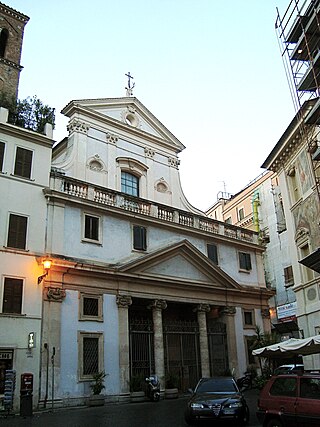
Sant'Eustachio is a Roman Catholic titular church and minor basilica in Rome, named for the martyr Saint Eustace. It is located on Via di Sant'Eustachio in the rione Sant'Eustachio, a block west of the Pantheon and via della Rotonda, and a block east of Sant'Ivo alla Sapienza and the Via della Dogana Vecchia.
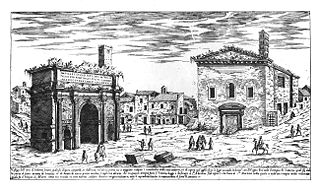
Sant'Adriano al Foro was a church in Rome, formerly in the Curia Julia in the Forum Romanum and a cardinal-deaconry.
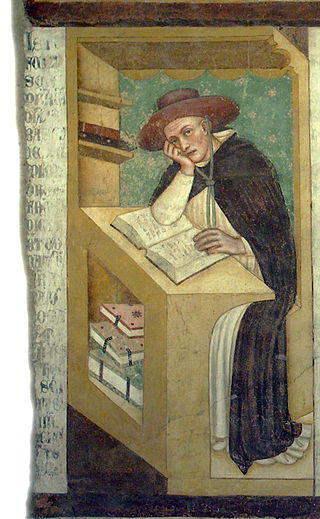
Annibaldo Annibaldi, also known as Annibaldo degli Annibaldi, was an Italian Catholic theologian,

The Diocese of Tivoli is a Latin Church ecclesiastical territory or diocese of the Catholic Church in Latium, Italy, which has existed since the 2nd century. In 2002 territory was added to it from the Territorial Abbey of Subiaco. The diocese is immediately exempt to the Holy See.

Gerardo Bianchi was an Italian churchman and papal diplomat, an important figure of the War of the Sicilian Vespers.
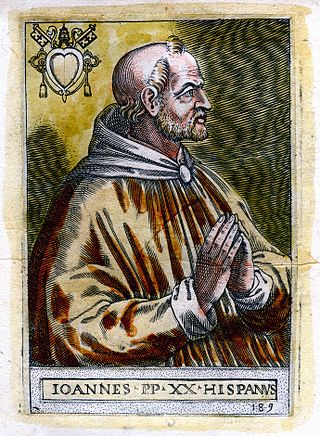
The September 1276 papal election is the only papal election to be the third election held in the same year; after Pope Gregory X died, two successors died that year, requiring yet another election. The election was also the first non-conclave, since the establishment of the papal conclave after the papal election, 1268–1271.

Napoleone Orsini was a Roman cardinal. His ecclesiastical career lasted 57 years, 54 of them as a cardinal, and included six conclaves.

The 1264–65 papal election was convened after the death of Pope Urban IV and ended by electing his successor Pope Clement IV. It met in Perugia, where Urban IV had taken refuge after being driven out of Orvieto. He had never been in Rome as Pope, but spent his entire reign in exile. It was the second election in a row where a pope was elected in absentia; the phenomenon would be repeated in the Conclave of 1268–1271, and again in the Conclave of 1292–1294. In the last two cases, the person elected was not even a Cardinal.
Cosma Orsini was an Italian Roman Catholic bishop and cardinal.
Gervasius Giançolet de Glincamp was born in the diocese of Mans, son of Gervais, great-grandson of Eudes, chevalier and seigneur de Groestel. He was a Roman Catholic cardinal and diplomat. He had a brother, Jean de Glincamp, who became Abbot of S. Remi in Reims. Another relative, a first-cousin, Robert de Glincamp, was bishop of Mans (1298-1309).
Geoffroy de Bar or Barbeau, of Burgundy, was a French cardinal and member of the Roman Curia. He died in 1287.
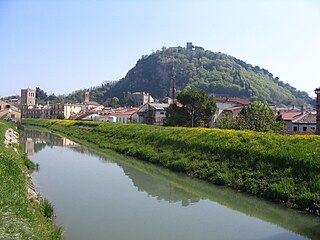
Simone Paltanieri, son of Pesce Paltanieri, member of a distinguished family, was an Italian Roman Catholic cardinal.

The Roman Catholic Diocese of Ortona a Mare e Campli was a Roman Catholic diocese in Italy, located in the city of Ortona, in the Province of Chieti in the Italian region of Abruzzo. In 1834, it was united with the Archdiocese of Lanciano to form the Archdiocese of Lanciano.
















